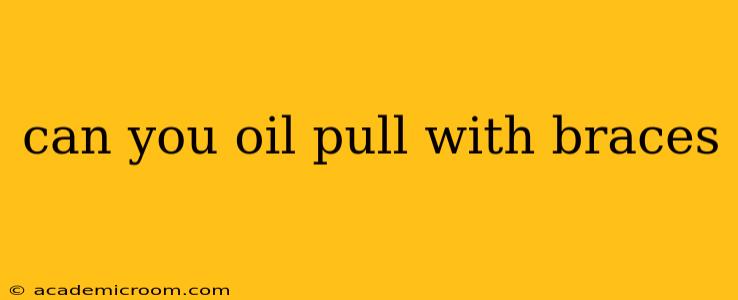Oil pulling, an ancient Ayurvedic practice involving swishing oil in your mouth, has gained popularity for its purported oral health benefits. However, if you have braces, you might wonder if this practice is safe and effective. The short answer is: it's generally possible, but with important modifications and considerations.
This guide will delve into the specifics, addressing common questions and concerns surrounding oil pulling with braces. We'll explore the potential benefits and risks, offering practical advice to help you decide if oil pulling is right for you.
What are the benefits of oil pulling?
Oil pulling proponents claim it can improve oral hygiene by reducing bacteria and plaque buildup. Some believe it can also whiten teeth, improve gum health, and even reduce bad breath. However, scientific evidence supporting these claims is limited and largely anecdotal. More research is needed to definitively confirm these benefits.
Can oil pulling damage my braces?
While oil pulling itself isn't likely to directly damage your braces, there are potential risks to consider:
- Trapped oil: The oil can get trapped around your brackets and wires, potentially leading to staining or difficulty cleaning.
- Increased plaque buildup: If not performed correctly, oil pulling could inadvertently lead to increased plaque accumulation in hard-to-reach areas around your braces.
- Dislodged brackets: Although unlikely, vigorously swishing oil could potentially dislodge a bracket, requiring a visit to your orthodontist.
How to oil pull safely with braces (if you choose to):
If you decide to try oil pulling despite having braces, follow these crucial steps:
- Use a smaller amount of oil: Start with a smaller amount of oil than you would without braces to minimize the risk of trapping it around your appliances.
- Swish gently: Avoid vigorous swishing to prevent dislodging brackets or wires. Gentle, rhythmic movements are sufficient.
- Rinse thoroughly: Pay extra attention to rinsing around your braces to remove all traces of oil.
- Floss carefully: After oil pulling, floss meticulously to remove any residual oil or food particles trapped around your brackets and wires.
- Brush meticulously: Brush your teeth and braces thoroughly afterward, using a soft-bristled toothbrush designed for braces.
- Consult your orthodontist: It's crucial to discuss oil pulling with your orthodontist before starting. They can provide personalized advice based on your specific orthodontic situation.
What type of oil is best for oil pulling?
Commonly used oils for oil pulling include coconut oil, sesame oil, and sunflower oil. Choose an oil that you find palatable and that doesn't leave a lingering unpleasant taste.
What if I experience any problems after oil pulling with braces?
If you experience any discomfort, pain, or notice any issues with your braces after oil pulling (like a loose bracket), contact your orthodontist immediately.
Is oil pulling a replacement for regular brushing and flossing?
Absolutely not. Oil pulling should never be considered a substitute for regular brushing, flossing, and professional dental cleanings. It's an adjunct practice, not a replacement for standard oral hygiene routines.
Are there any alternatives to oil pulling for improving oral hygiene with braces?
Maintaining good oral hygiene with braces requires diligent brushing and flossing. Using an interdental brush or a water flosser can help remove food particles and plaque from around your braces. Your orthodontist can offer further recommendations on effective cleaning techniques.
Remember, maintaining excellent oral hygiene is crucial, especially when you have braces. Consult your orthodontist before trying any new oral hygiene practices, including oil pulling, to ensure it's appropriate for your specific situation. They can provide the best advice for maintaining a healthy and beautiful smile while wearing braces.
